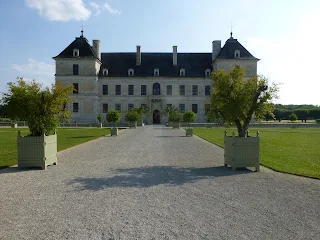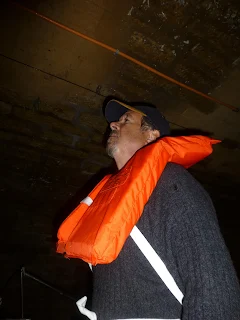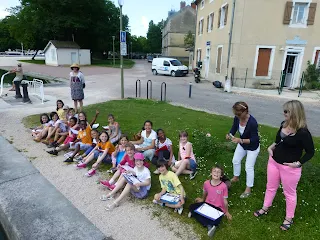One more lock will
take us from the canal de Bourgogne
onto the River Yonne. We have visited this town of Migennes
several times before. The fact that it may not be the most beautiful in France
is thanks mainly to its railway. During WW2 the Allied bombing raids destroyed
the rail marshalling yards, the bridges over the river and, unfortunately, much
of the town itself. Today, whilst the uninspiringly rebuilt Migennes remains a
convenient place to catch a train and stock up with fuel and food, it also provides
a nightly magnificent spectacle – the murmuration of thousands upon thousands
of starlings. One starling on its own may not conjure up any particular vision
of beauty but believe me en masse they are absolutely spellbinding.
Burgundy has
always been a rich region of France
and consequently it has many fine chateaux some of which have been owned by the
same families for generations. Evidently there were some aristocrats who
managed to hang onto not only their heads but also their castles during the
Revolution. Many are open to the public and we visited those closest to the
canal. Some don’t allow visitors.
 |
| Chateau Tanlay |
 |
| Chateau Ancy le Franc |
One of the latter is the chateau at Marigny le Cahouet. A
Frenchman we met at Port Royal told us to be sure to
stop at this little village to see ‘the very beautiful castle’. We had had a
hard day; heavy locks coming every few hundred metres, in very hot weather,
with our young, slightly built, female travelling lock keeper. By the time we
reached the last lock before Marigny we’d all had enough. We told her we were
stopping and after telling us the ‘halte’ was just round the corner she made
her escape zooming off down the tow path on her scooter.
 |
| Marigny le Cahouet |
‘Round the corner’ was a short distance and the mooring was
just before the next lock. A couple of boats were already tied up. One was a
narrowboat we had travelled with previously and as we drew near they came out
to call to us that the canal was so shallow that they’d had to tie up well out
from the bank and use a gangplank. Worse though was apparently the water level
dropped considerably overnight and they had been woken that morning not by
church bells but by the rather more upsetting clatter of their cupboards
emptying themselves onto the floor as their boat listed. Our boat, having a
much deeper draught, meant there was no chance of us getting alongside. Without
a lock keeper we could neither go on nor back so we just had to try and find a
bit where we could get close enough to the bank for the ‘great leap’ into the
inevitable nettles.
With much palaver (ie cursing and swearing) we’d no sooner
hammered in stakes and manhandled the gangplank ashore when the lock keeper and
a colleague hove into view at the next lock to fill it in order to let 2 more
boats up into our section. Filling the lock was going to put us all seriously
aground so I put my best French into action (thanks Sylvianne) and went to
remonstrate ( the French for shallow is ‘peau profonde’ in case you’re
interested). The upshot was that they let the boats through but were persuaded
to call up the boss keeper who then made an appearance and agreed to let more
water down so we could all be afloat again. However, he did insist we move our
boat to the opposite bank where the official mooring was. More ‘palaver’. Next
morning we were all hard aground again but yesterday’s last yacht in, being
fairly light, was refloated before anyone else was even up and they dashed into
the lock. Extraordinary bad manners, the protocol being that one queues for the
lock in the order of arrival. Someone, and I have a fair idea who you are,
stole our boathook that day. Boathooks are a vital piece of equipment on a boat
with many, many uses. One of those is pushing a boat off should it run aground.
May you have great need of it in the future,
Our reason for stopping here was not in evidence. No hill
with a castle on top. None of the other boaters had any idea of where it might
be, nor did the lock keeper. So, I set off on foot to look. In the village I
found a rue du Chateau which, being a fair clue, I followed and eventually
found the castle in question and also a beautiful ancient stone footbridge. The
chateau had a sign saying no visitors so I contented myself with a solitary wander
around the moat.
 |
| Marigny le Cahouet |
On my way back to the boat I called into the baker’s shop
which adjoined the village bar with a connecting door inside. The baker, who
had a broken arm (which may explain why his croissants were so heavy you could
have used them as boat anchors) was also the barman. He was very friendly and I
asked him who owned the beautiful chateau. ‘Ah!! Le Dijonais’ ( I think that’s
what he said. He didn’t speak any English). ‘He’s the owner and he’s in the bar
now! Come and meet him and he’ll take you to the chateau and show you around.’
Suddenly I was on the spot. The bar was a typical French village bar - full of
men laughing and talking at full volume whilst having a drink on their way
home. No women. ‘Come on,’ he encouraged but I’m sorry to say I shyly declined.
Now I am sorry.
What a missed opportunity.
Lavoirs. I love these
old communal washing places. There are a few beauties along this canal. Should
you be interested in a little history see the page link on the right.
 |
| Fosse Dion, Tonnerre |
 |
| Grand Lavoir, Brienon |


































